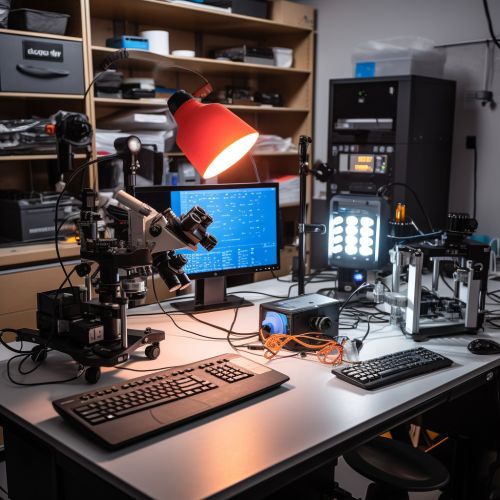Optogenetics
Introduction
Optogenetics is a biological technique that involves the use of light to control cells within living tissue, typically neurons, that have been genetically modified to express light-sensitive ion channels. The technique is a rapidly evolving field that combines the disciplines of optics and genetics to control and monitor the activities of individual neurons in living tissue and to precisely measure these control effects in real-time.
History
The field of optogenetics traces its roots to early experiments in the late 20th century. However, the term "optogenetics" was coined only in 2006 by the researchers Deisseroth and Boyden at Stanford University. The technique has since been widely adopted in neuroscience due to its ability to manipulate neuronal activity with high temporal precision.


Principles of Optogenetics
Optogenetics relies on the expression of proteins that respond to light, known as opsins, in specific cells. These opsins are ion channels or pumps that move ions across the cell membrane in response to specific wavelengths of light, thereby changing the electrical activity of the cell.
Opsins
Opsins are a group of proteins that function as light-sensitive ion channels or pumps. They are found in a wide variety of organisms and are responsible for various light-dependent processes. In optogenetics, opsins are used to control the activity of neurons by changing their membrane potential in response to light.
Light Delivery
In optogenetics, light is delivered to the target cells using a variety of methods. The most common method is the use of an optical fiber that is implanted in the brain. The light can be of various wavelengths, depending on the type of opsin used.
Applications of Optogenetics
Optogenetics has a wide range of applications in neuroscience and other fields. It is used to study the function of specific neurons in the brain, to map neural circuits, and to understand the basis of neurological disorders.
Neuroscience
In neuroscience, optogenetics is used to control and monitor the activities of individual neurons in living tissue. This allows researchers to study the function of specific neurons and to map neural circuits.
Neurological Disorders
Optogenetics has also been used to study and potentially treat neurological disorders. By controlling the activity of specific neurons, researchers can gain insights into the mechanisms underlying these disorders and develop potential treatments.
Future Directions
The field of optogenetics is rapidly evolving, with new opsins and light delivery methods being developed. Future directions include the development of new opsins with improved properties, the development of non-invasive light delivery methods, and the application of optogenetics in other fields.
